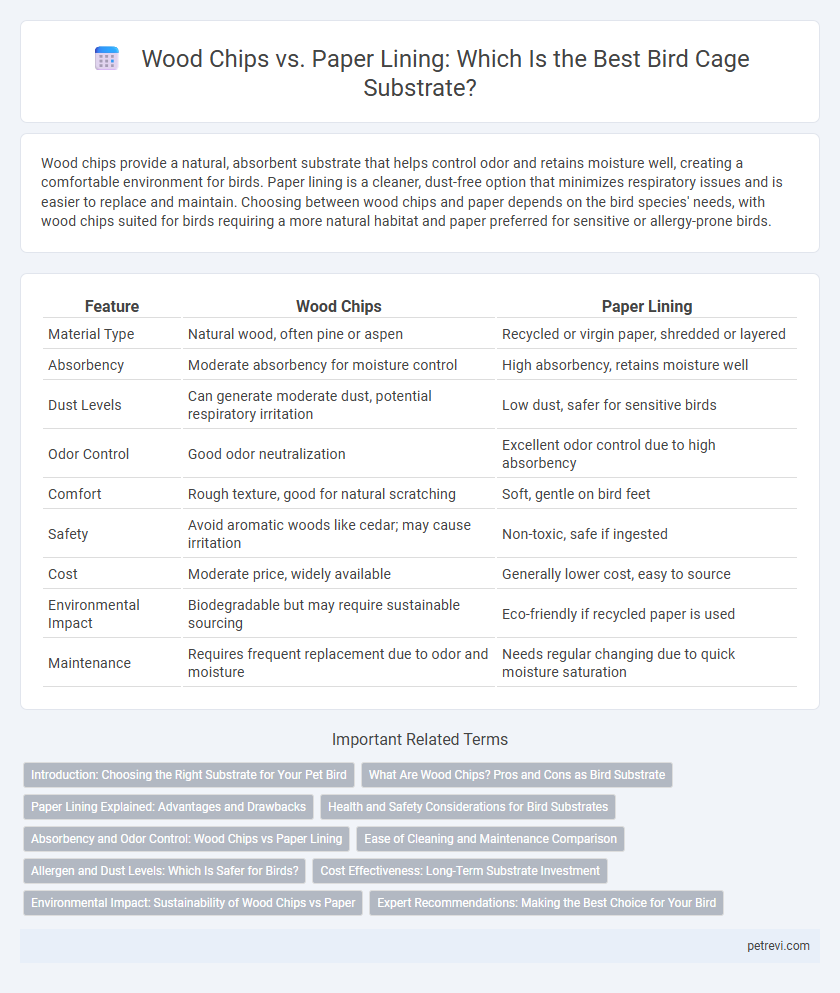Wood chips provide a natural, absorbent substrate that helps control odor and retains moisture well, creating a comfortable environment for birds. Paper lining is a cleaner, dust-free option that minimizes respiratory issues and is easier to replace and maintain. Choosing between wood chips and paper depends on the bird species' needs, with wood chips suited for birds requiring a more natural habitat and paper preferred for sensitive or allergy-prone birds.
Table of Comparison
| Feature | Wood Chips | Paper Lining |
|---|---|---|
| Material Type | Natural wood, often pine or aspen | Recycled or virgin paper, shredded or layered |
| Absorbency | Moderate absorbency for moisture control | High absorbency, retains moisture well |
| Dust Levels | Can generate moderate dust, potential respiratory irritation | Low dust, safer for sensitive birds |
| Odor Control | Good odor neutralization | Excellent odor control due to high absorbency |
| Comfort | Rough texture, good for natural scratching | Soft, gentle on bird feet |
| Safety | Avoid aromatic woods like cedar; may cause irritation | Non-toxic, safe if ingested |
| Cost | Moderate price, widely available | Generally lower cost, easy to source |
| Environmental Impact | Biodegradable but may require sustainable sourcing | Eco-friendly if recycled paper is used |
| Maintenance | Requires frequent replacement due to odor and moisture | Needs regular changing due to quick moisture saturation |
Introduction: Choosing the Right Substrate for Your Pet Bird
Wood chips offer a natural texture that mimics a bird's wild environment, providing excellent odor control and cushioning for feet. Paper lining is highly absorbent, cost-effective, and reduces the risk of ingestion-related issues often associated with wood chips. Selecting the right substrate balances hygiene, safety, and comfort to promote your pet bird's overall wellbeing.
What Are Wood Chips? Pros and Cons as Bird Substrate
Wood chips, typically made from hardwoods like pine or aspen, serve as a common bird substrate due to their absorbency and natural odor control. They provide a soft, cushioning surface that reduces foot sores but may harbor bacteria if not regularly cleaned, posing health risks to birds. While wood chips are biodegradable and inexpensive, some types can produce harmful dust or contain toxic oils, making species selection critical for safe bird environments.
Paper Lining Explained: Advantages and Drawbacks
Paper lining as a bird substrate offers a clean, dust-free environment that reduces respiratory issues and makes daily cage maintenance simple due to its easy disposal and replacement. It absorbs moisture effectively but requires frequent changing to prevent bacterial buildup and odor. Compared to wood chips, paper lining poses less risk of toxicity and irritation, making it a safer choice for sensitive bird species.
Health and Safety Considerations for Bird Substrates
Wood chips and paper lining serve as common bird substrates, with wood chips providing natural absorbency and odor control but posing respiratory risks due to dust and potential mold exposure. Paper lining offers a safer, hypoallergenic alternative that reduces dust inhalation and minimizes bacterial growth, promoting respiratory health in birds. Selecting untreated, chemical-free materials is crucial for avoiding toxin-related illnesses and supporting a hygienic bird environment.
Absorbency and Odor Control: Wood Chips vs Paper Lining
Wood chips provide superior absorbency, effectively trapping moisture and reducing the risk of bacterial growth in bird enclosures. Paper lining offers excellent odor control by neutralizing ammonia buildup more rapidly due to its dense fiber composition. Choosing between wood chips and paper lining depends on specific needs for moisture management and odor reduction in bird habitats.
Ease of Cleaning and Maintenance Comparison
Wood chips provide a natural texture that absorbs moisture effectively, facilitating easier removal of droppings and reducing odor buildup in bird cages. Paper lining, being smooth and disposable, allows for quick replacement and less frequent deep cleaning but may become soggy faster, requiring more frequent changes to maintain hygiene. Choosing between wood chips and paper lining depends on balancing the bird species' comfort needs with the owner's preferred cleaning frequency and ease of maintenance.
Allergen and Dust Levels: Which Is Safer for Birds?
Wood chips often contain natural oils and dust particles that can trigger respiratory issues and allergies in birds, especially species sensitive to airborne irritants. Paper lining produces significantly less dust and is hypoallergenic, making it a safer option for maintaining clean air quality in bird habitats. Choosing paper substrate reduces the risk of allergic reactions and respiratory distress, promoting overall avian health and comfort.
Cost Effectiveness: Long-Term Substrate Investment
Wood chips offer a cost-effective bird substrate with durability that reduces frequent replacements, making them ideal for long-term investment. Paper lining, while initially cheaper, tends to wear out quickly, increasing maintenance costs over time. Selecting wood chips balances upfront expenses with sustained usage, optimizing long-term financial efficiency.
Environmental Impact: Sustainability of Wood Chips vs Paper
Wood chips, typically sourced from forestry byproducts, offer a biodegradable and renewable substrate but can contribute to deforestation if not sustainably harvested. Paper lining, often made from recycled materials, presents a lower environmental footprint due to its recycling process and reduced demand on natural resources. Choosing paper substrates supports waste reduction and promotes sustainable resource management compared to traditional wood chip use.
Expert Recommendations: Making the Best Choice for Your Bird
Experts recommend choosing bird substrate based on species-specific needs, with wood chips preferred for larger birds due to better odor control and natural foraging opportunities. Paper lining is favored for smaller birds and those prone to dust allergies, as it is dust-free, easy to clean, and minimizes respiratory risks. Prioritizing substrate that supports hygiene, comfort, and natural behaviors ensures optimal bird health and well-being.
Wood chips vs Paper lining for Bird substrate Infographic

 petrevi.com
petrevi.com